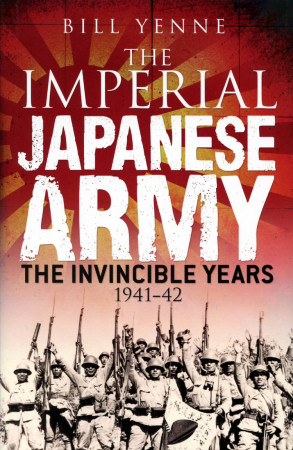
The Imperial Japanese Army: The Invincible Years 1941-42 Book Review
By David L. Veres
| Date of Review | October 2014 | Title | The Imperial Japanese Army: The Invincible Years 1941-42 |
|---|---|---|---|
| Author | Christopher McNab | Publisher | Osprey Publishing |
| Published | 2014 | ISBN | 9781782009320 |
| Format | 360 pages, hardbound | MSRP (USD) | $29.95 |
Review
Shooting stars burn brilliantly – but briefly. They race and awe and die – in fantastic, but fleeting fashion.
Thus did the Imperial Japanese Army (IJA) shock the world with six months of stunning victories over its vaunted Western adversaries: The United States, British Commonwealth, and Netherlands East Indies. From Dec 1941 through May 1942, it conquered Hong Kong, the Philippines, Singapore, Burma, and the Netherlands East Indies.
Osprey now chronicles Japan's early, meteoric successes in The Imperial Japanese Army: The Invincible Years 1941-42 by Bill Yenne.
Coverage commences with three wars, two men and one army – Japan's rogue Kwantung Army in China.
Having emerged from centuries of isolation, Japanese forces forged victories in the the Sino-Japanese War of 1894, the Boxer Rebellion operations in 1900, and the Russo-Japanese War of 1904-1905.
The cauldron of fin de siècle combat transformed Japan into a world power, deeply influencing two young officers – Hideki Tojo and Tomoyuki Yamashita. And in the wake of WWI, Japan's Kwantung Army in China proved the "catalyst for independent actions in Manchuria in China that would define Japanese foreign-policy and lead Japan toward World War II".
Coverage subsequently courses through all major pre-World War II IJA combat actions. The fall of Shanghai. The "Rape of Nanking". Lake Khasan. Khalkhyn Gol. The last two, decisive defeats for Japan, steered Imperial ambitions southward – Nashinron [Nashin-ron].
Politics also drove events. Japanese diplomats inked the Axis Tripartite Pact with Nazi Germany and Fascist Italy. And the United States drastically curtailed the export of war materials, notably oil, to resource-poor Japan – and froze Imperial assets.
All set the stage for war in the Pacific. The IJA forged a new level of cooperation with its rival service, the Imperial Japanese Navy – a necessity for coming seaborne operations against Malaya, the Phillipines and the Netherlands East Indies.
When war came, Allied defenders responded with command confusion, asset mismanagement and internecine incidents. Japanese, by contrast, maintained strategic initiative, superbly leveraging speed, tactical superiority and captured resources to their advantage.
A "premium on lightness and mobility," author Yenne notes, "prevailed". As commander of the 25th Army during the invasion of Malaya, for instance, Tomoyuki Yamashita employed 6,000 bicycles, abandoned British vehicles and captured fuel stocks in his relentless thrust toward Singapore.
Everywhere, the demoralized defenders retreated – often in the face of numerically inferior, deftly deployed Japanese forces. Prewar planning failed to project the actual resources required to stem Japan's relentless attacks.
Nevertheless, the Allies scored some – albeit minor – successes. When Yamashita executed "a bold amphibious flanking maneuver" in his assault on Bataan, American and Philippine forces soundly defeated enemy forces in the "Battle of the Points". And four American destroyers wrecked havoc among Japanese warships and transports invading Balikpapan in Borneo.
But those Allied tactical triumphs proved ephemeral. Imperial Japan rapidly achieved its strategic objectives. Singapore fell. Borneo. The "stepping stones" of the Netherlands East Indies. The Java Sea. Burma. And, finally, in May 1942, all of the Philippines. Yenn aptly recaps Japan's irresistible onslaught – and the Allies' grim litany of depressing defeats.
Conquests spawn consequences. And Osprey also competently covers the fates of vanquished lands under Japanese rule. The Greater East Asia Co-Prosperity Sphere's lie of "Asia for Asiatics" quickly degenerated into sham puppet governments or outright annexation to Japan's empire – the latter, Yenn notes, "based on the Korea and Taiwan model".
What a convenient history. Everything comes packed in 360 pages, six parts and 32 chapters. Over 30 photos, three illustrations, nine maps, introductory notes, glossary and index supplement text. An epilogue recounts fates of principal participants. But despite several attributions, the disappointing lack of annotations undermines the scholarly usefulness of this otherwise instructive effort.
Recommended.
My sincere thanks to Osprey Publishing for this review sample!







